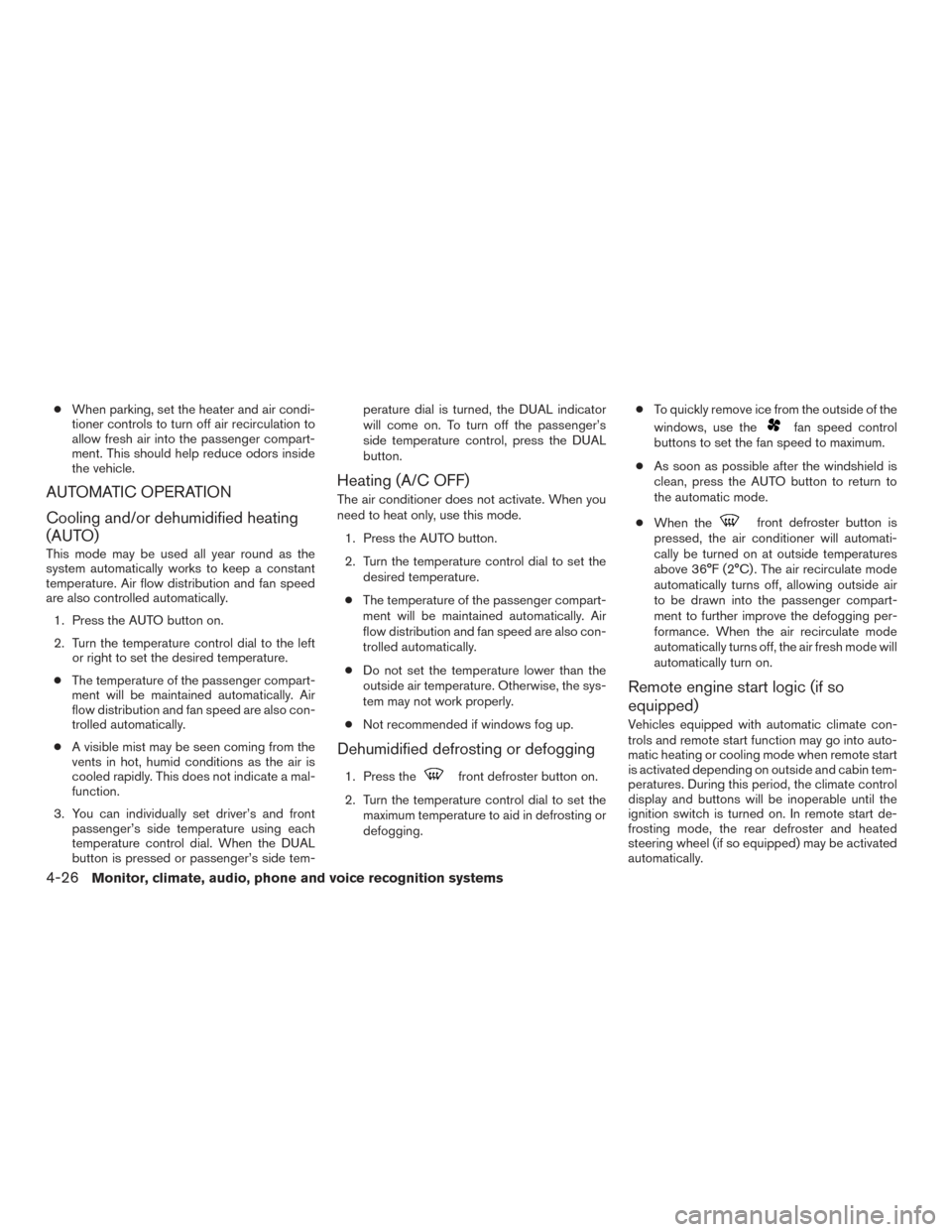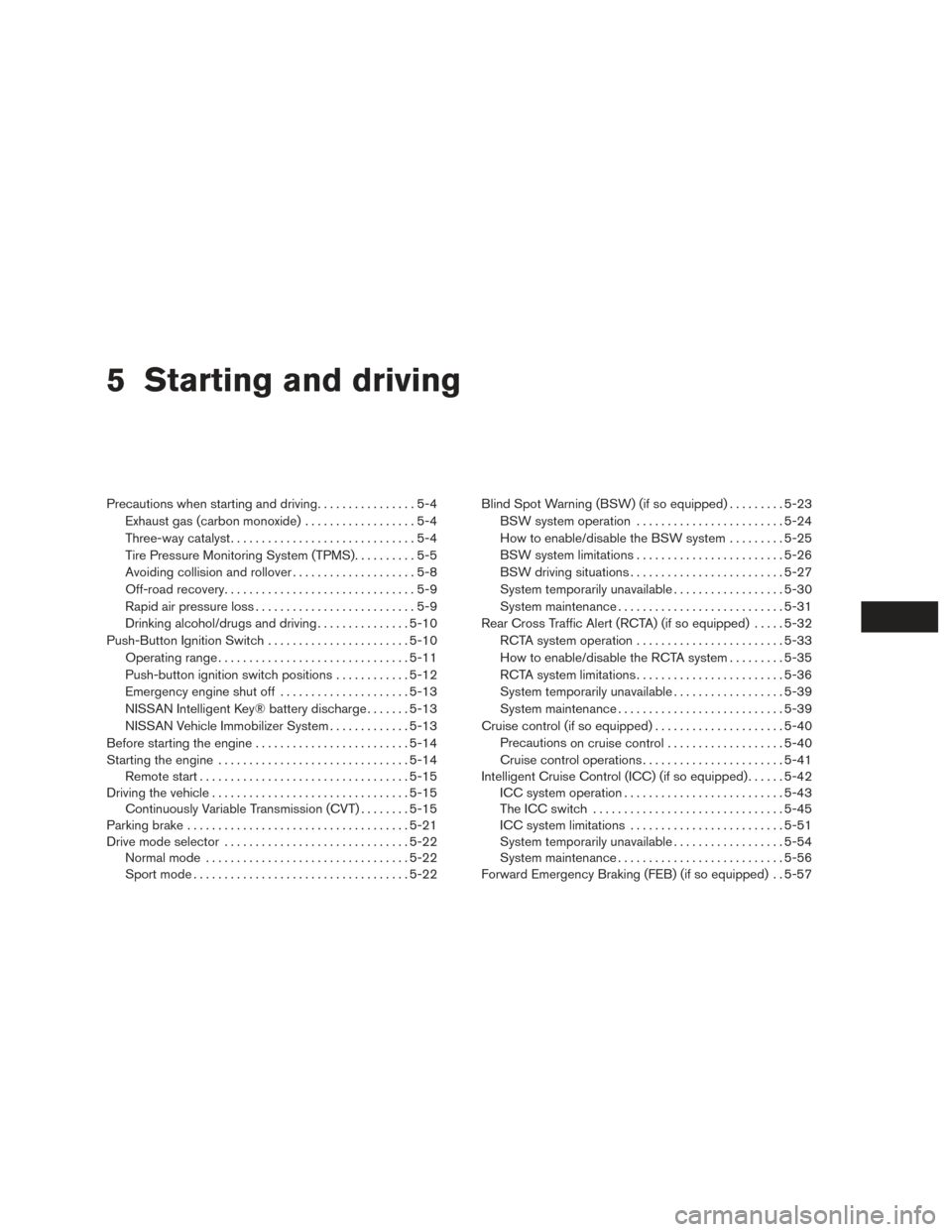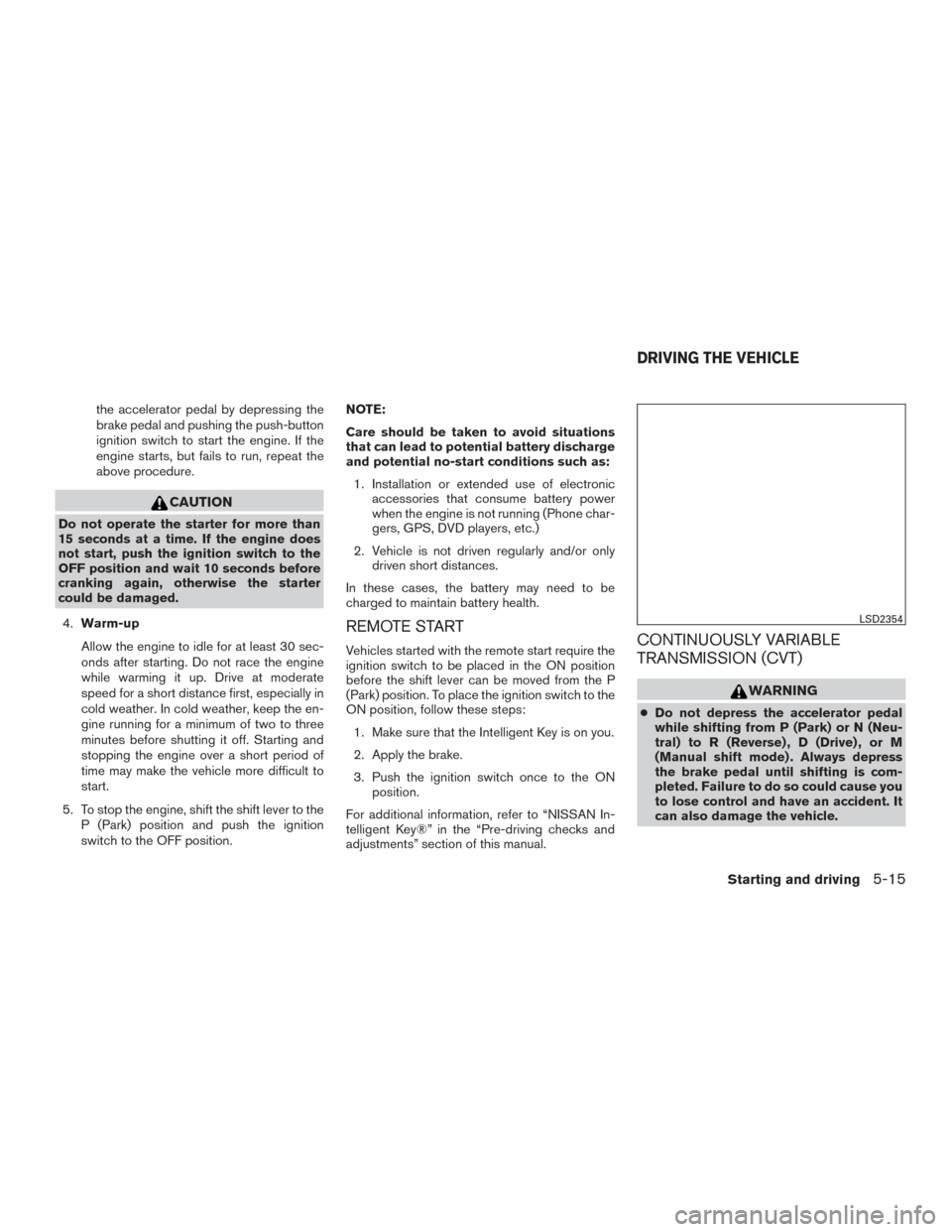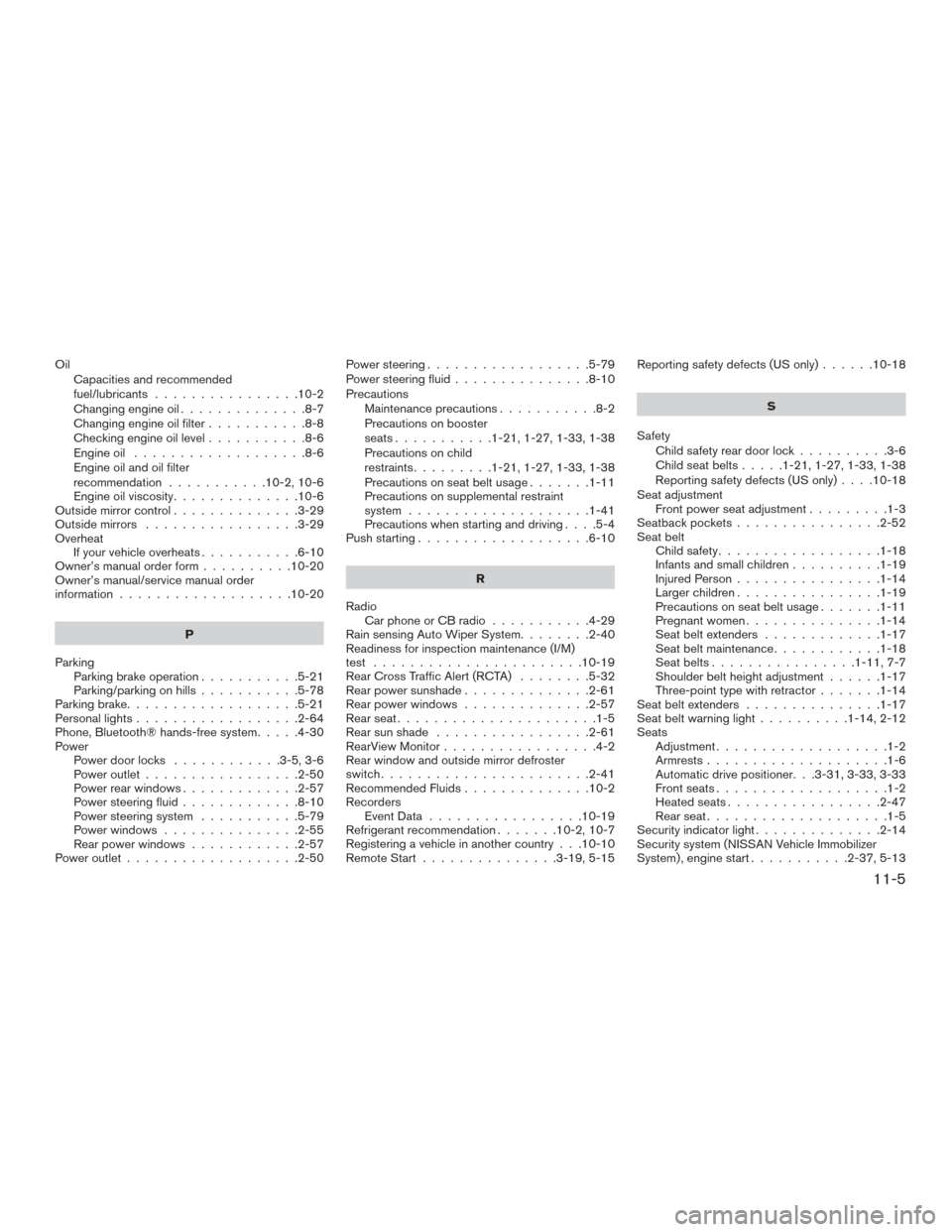2017 NISSAN MAXIMA remote control
[x] Cancel search: remote controlPage 207 of 406

●When parking, set the heater and air condi-
tioner controls to turn off air recirculation to
allow fresh air into the passenger compart-
ment. This should help reduce odors inside
the vehicle.
AUTOMATIC OPERATION
Cooling and/or dehumidified heating
(AUTO)
This mode may be used all year round as the
system automatically works to keep a constant
temperature. Air flow distribution and fan speed
are also controlled automatically.
1. Press the AUTO button on.
2. Turn the temperature control dial to the left or right to set the desired temperature.
● The temperature of the passenger compart-
ment will be maintained automatically. Air
flow distribution and fan speed are also con-
trolled automatically.
● A visible mist may be seen coming from the
vents in hot, humid conditions as the air is
cooled rapidly. This does not indicate a mal-
function.
3. You can individually set driver’s and front passenger’s side temperature using each
temperature control dial. When the DUAL
button is pressed or passenger’s side tem- perature dial is turned, the DUAL indicator
will come on. To turn off the passenger’s
side temperature control, press the DUAL
button.
Heating (A/C OFF)
The air conditioner does not activate. When you
need to heat only, use this mode.
1. Press the AUTO button.
2. Turn the temperature control dial to set the desired temperature.
● The temperature of the passenger compart-
ment will be maintained automatically. Air
flow distribution and fan speed are also con-
trolled automatically.
● Do not set the temperature lower than the
outside air temperature. Otherwise, the sys-
tem may not work properly.
● Not recommended if windows fog up.
Dehumidified defrosting or defogging
1. Press thefront defroster button on.
2. Turn the temperature control dial to set the maximum temperature to aid in defrosting or
defogging. ●
To quickly remove ice from the outside of the
windows, use the
fan speed control
buttons to set the fan speed to maximum.
● As soon as possible after the windshield is
clean, press the AUTO button to return to
the automatic mode.
● When the
front defroster button is
pressed, the air conditioner will automati-
cally be turned on at outside temperatures
above 36°F (2°C) . The air recirculate mode
automatically turns off, allowing outside air
to be drawn into the passenger compart-
ment to further improve the defogging per-
formance. When the air recirculate mode
automatically turns off, the air fresh mode will
automatically turn on.
Remote engine start logic (if so
equipped)
Vehicles equipped with automatic climate con-
trols and remote start function may go into auto-
matic heating or cooling mode when remote start
is activated depending on outside and cabin tem-
peratures. During this period, the climate control
display and buttons will be inoperable until the
ignition switch is turned on. In remote start de-
frosting mode, the rear defroster and heated
steering wheel (if so equipped) may be activated
automatically.
4-26Monitor, climate, audio, phone and voice recognition systems
Page 212 of 406

5 Starting and driving
Precautions when starting and driving................5-4
Exhaust gas (carbon monoxide) ..................5-4
Three-way catalyst ..............................5-4
Tire Pressure Monitoring System (TPMS) ..........5-5
Avoiding collision and rollover . . ..................5-8
Off-road recovery ...............................5-9
Rapid air pressure loss ..........................5-9
Drinking alcohol/drugs and driving ...............5-10
Push-Button Ignition Switch .......................5-10
Operating range ............................... 5-11
Push-button ignition switch positions . . . .........5-12
Emergency engine shut off .....................5-13
NISSAN Intelligent Key® battery discharge .......5-13
NISSAN Vehicle Immobilizer System .............5-13
Before starting the engine ......................... 5-14
Starting the engine ............................... 5-14
Remote start .................................. 5-15
Driving the vehicle ................................ 5-15
Continuously Variable Transmission (CVT) ........5-15
Parking brake .................................... 5-21
Drive mode selector .............................. 5-22
Normal mode ................................. 5-22
Sport mode ................................... 5-22Blind Spot Warning (BSW) (if so equipped)
.........5-23
BSW system operation ........................ 5-24
How to enable/disable the BSW system .........5-25
BSW system limitations ........................ 5-26
BSW driving situations ......................... 5-27
System temporarily unavailable ..................5-30
System maintenance ........................... 5-31
Rear Cross Traffic Alert (RCTA) (if so equipped) .....5-32
RCTA system operation ........................ 5-33
How to enable/disable the RCTA system .........5-35
RCTA system limitations ........................ 5-36
System temporarily unavailable ..................5-39
System maintenance ........................... 5-39
Cruise control (if so equipped) . . ...................5-40
Precautions
on cruise control ................... 5-40
Cruise control operations .......................5-41
Intelligent Cruise Control (ICC) (if so equipped) ......5-42
ICC system operation .......................... 5-43
The ICC switch ............................... 5-45
ICC system limitations ......................... 5-51
System temporarily unavailable ..................5-54
System maintenance ........................... 5-56
Forward Emergency Braking (FEB) (if so equipped) . . 5-57
Page 226 of 406

the accelerator pedal by depressing the
brake pedal and pushing the push-button
ignition switch to start the engine. If the
engine starts, but fails to run, repeat the
above procedure.
CAUTION
Do not operate the starter for more than
15 seconds at a time. If the engine does
not start, push the ignition switch to the
OFF position and wait 10 seconds before
cranking again, otherwise the starter
could be damaged.4. Warm-up
Allow the engine to idle for at least 30 sec-
onds after starting. Do not race the engine
while warming it up. Drive at moderate
speed for a short distance first, especially in
cold weather. In cold weather, keep the en-
gine running for a minimum of two to three
minutes before shutting it off. Starting and
stopping the engine over a short period of
time may make the vehicle more difficult to
start.
5. To stop the engine, shift the shift lever to the P (Park) position and push the ignition
switch to the OFF position. NOTE:
Care should be taken to avoid situations
that can lead to potential battery discharge
and potential no-start conditions such as:
1. Installation or extended use of electronic accessories that consume battery power
when the engine is not running (Phone char-
gers, GPS, DVD players, etc.)
2. Vehicle is not driven regularly and/or only driven short distances.
In these cases, the battery may need to be
charged to maintain battery health.
REMOTE START
Vehicles started with the remote start require the
ignition switch to be placed in the ON position
before the shift lever can be moved from the P
(Park) position. To place the ignition switch to the
ON position, follow these steps: 1. Make sure that the Intelligent Key is on you.
2. Apply the brake.
3. Push the ignition switch once to the ON position.
For additional information, refer to “NISSAN In-
telligent Key®” in the “Pre-driving checks and
adjustments” section of this manual.CONTINUOUSLY VARIABLE
TRANSMISSION (CVT)
WARNING
● Do not depress the accelerator pedal
while shifting from P (Park) or N (Neu-
tral) to R (Reverse) , D (Drive) , or M
(Manual shift mode) . Always depress
the brake pedal until shifting is com-
pleted. Failure to do so could cause you
to lose control and have an accident. It
can also damage the vehicle.
LSD2354
DRIVING THE VEHICLE
Starting and driving5-15
Page 400 of 406

FuelCapacities and recommended
fuel/lubricants ................10-2
Fuel economy ................5-77
Fuel-filler cap .................3-24
Fuel-filler lid .................3-24
Fuel gauge ...................2-6
Fuel octane rating ..............10-5
Fuel recommendation .........10-2,10-3
Loose fuel cap warning ...........2-29
Fuel efficient driving tips .............5-76
Fuel-filler door ..................3-24
Fuel gauge .....................2-6
Fuses.......................8-18
Fusible links ...................8-19
G
Garage door opener, HomeLink® Universal
Transceiver . .2-64, 2-65, 2-66, 2-67, 2-67, 2-68
Gascap .....................3-24
Gauge Engine coolant temperature gauge .....2-5
Fuel gauge ...................2-6
Odometer ...................2-4
Speedometer .................2-4
Tachometer ..................2-5
Trip odometer .................2-4
General maintenance ...............9-2
Glovebox.....................2-53
Gloveboxlock..................2-53 H
Hands-free phone system, Bluetooth® ....4-30
Hazard warning flasher switch ..........6-2
Headlight and turn signal switch ........2-42
Headlight control switch ............2-42
Headlights ....................8-23
Head restraints ..................1-7
Heated seats ...................2-47
Heated seat switches ..............2-47
Heated steering wheel switch .........2-48
Heater Heater and air conditioner (automatic)
(if so equipped) ...............4-25
Heater and air conditioner controls .....4-26
Heater operation ...............4-27
Heater and air conditioner (automatic) .....4-25
HomeLink® Universal Transceiver . . .2-64, 2-65, 2-66, 2-67, 2-67, 2-68
Hood .......................3-21
Horn .......................2-46
I
Ignition Switch Push-Button Ignition Switch ........5-10
Immobilizer system ............2-37,5-13
Important vehicle information label ......10-11
In-cabin microfilter ................8-16
Increasing fuel economy .............5-77
Indicator NISSAN Intelligent Key® battery discharge
indicator ...................5-13 Indicator lights and audible reminders
(See warning/indicator lights and audible
reminders)..................2-7,2-12
Information display
................2-15
Inside automatic anti-glare mirror ........3-29
Instrument brightness control ..........2-45
Instrumentpanel...............0-6,2-2
Instrument panel dimmer switch ........2-45
Integrated Dynamics-control Module ......5-84
Intelligent cruise control (ICC) system Brake
assist.................5-42
Intelligent Key system Key operating range ..............3-8
Key operation .................3-9
Mechanical key ................3-3
Remote keyless entry operation.......3-12
Troubleshooting guide ............3-17
Warning signals ...............3-17
Interior light ....................2-62
Interior trunk lid release .............3-23
ISOFIX child restraints .............1-23
J
Jump starting ................6-8,8-13
K
Key.........................3-2
Key fob battery replacement ..........8-21
Keyless entry With Intelligent Key system
(See Intelligent Key system) .........3-12
11-3
Page 402 of 406

OilCapacities and recommended
fuel/lubricants ................10-2
Changing engine oil ..............8-7
Changing engine oil filter ...........8-8
Checking engine oil level ...........8-6
Engine oil ...................8-6
Engine oil and oil filter
recommendation ...........10-2,10-6
Engine oil viscosity ..............10-6
Outside mirror control ..............3-29
Outside mirrors .................3-29
Overheat Ifyourvehicleoverheats...........6-10
Owner’s manual order form ..........10-20
Owner’s manual/service manual order
information ...................10-20
P
Parking Parking brake operation ...........5-21
Parking/parking on hills ...........5-78
Parking brake ...................5-21
Personallights..................2-64
Phone, Bluetooth® hands-free system .....4-30
Power Power door locks ............3-5,3-6
Power outlet .................2-50
Power rear windows .............2-57
Power steering fluid .............8-10
Power steering system ...........5-79
Power windows ...............2-55
Rear power windows ............2-57
Power outlet ...................2-50 Power steering
..................5-79
Power steering fluid ...............8-10
Precautions Maintenance precautions ...........8-2
Precautions on booster
seats...........1-21,1-27,1-33,1-38
Precautions on child
restraints .........1-21,1-27,1-33,1-38
Precautions on seat belt usage .......1-11
Precautions on supplemental restraint
system ....................1-41
Precautions when starting and driving ....5-4
Push starting ...................6-10
R
Radio Car phone or CB radio ...........4-29
Rain sensing Auto Wiper System ........2-40
Readiness for inspection maintenance (I/M)
test .......................10-19
Rear Cross Traffic Alert (RCTA) ........5-32
Rear power sunshade ..............2-61
Rear power windows ..............2-57
Rearseat......................1-5
Rear sun shade .................2-61
RearView Monitor .................4-2
Rear window and outside mirror defroster
switch .......................2-41
Recommended Fluids ..............10-2
Recorders EventData .................10-19
Refrigerant recommendation .......10-2,10-7
Registering a vehicle in another country . . .10-10
Remote Start ...............3-19,5-15 Reporting safety defects (US only)
......10-18
S
Safety Child safety rear door lock ..........3-6
Child seat belts .....
1-21,1-27,1-33,1-38
Reporting safety defects (US only) ....10-18
Seat adjustment Front power seat adjustment .........1-3
Seatbackpockets................2-52
Seat belt Child safety ..................1-18
Infants and small children ..........1-19
Injured Person ................1-14
Largerchildren................1-19
Precautions on seat belt usage .......1-11
Pregnant women ...............1-14
Seatbeltextenders .............1-17
Seatbeltmaintenance............1-18
Seatbelts................1-11,7-7
Shoulder belt height adjustment ......1-17
Three-point type with retractor .......1-14
Seat belt extenders ...............1-17
Seatbeltwarninglight..........1-14,2-12
Seats Adjustment ...................1-2
Armrests....................1-6
Automatic drive positioner. . .3-31, 3-33, 3-33
Frontseats...................1-2
Heatedseats.................2-47
Rearseat....................1-5
Security indicator light ..............2-14
Security system (NISSAN Vehicle Immobilizer
System) , engine start ...........2-37,5-13
11-5